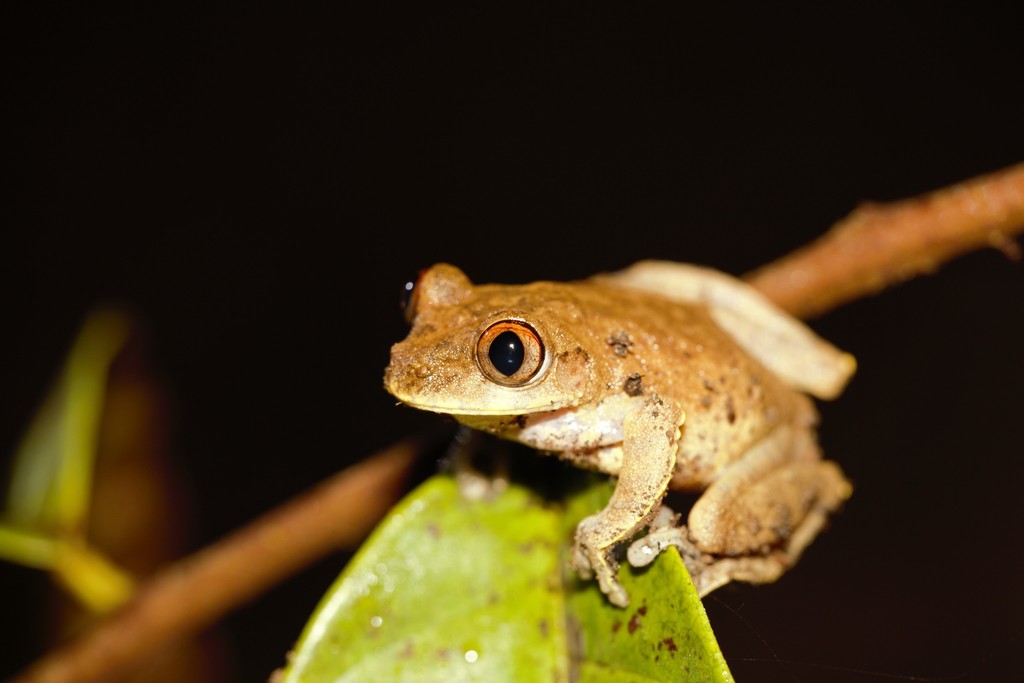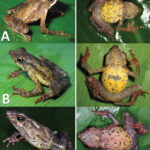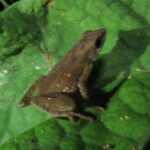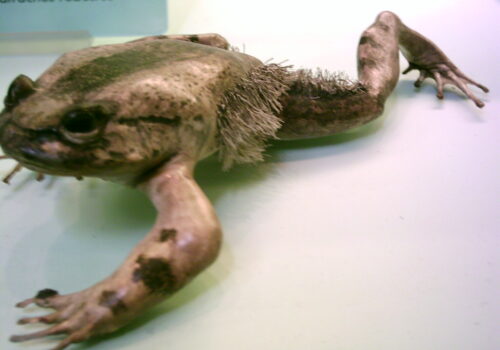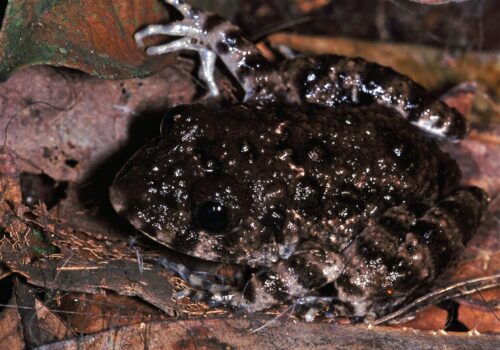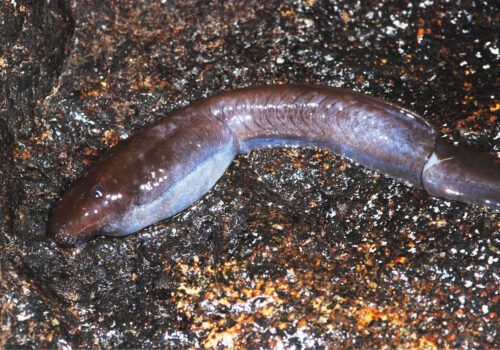- Hidden Gems of the Rainforest: Discovering the Enchanting Leptopelis aubryioides Frog
- Taxonomy and Classification: Understanding Leptopelis aubryioides
- A Rainforest Haven: Natural Habitat and Geographic Range
- Captivating Appearance: Physical Characteristics and Adaptations
- Life Among the Leaves: Behavior and Life Cycle
- A Vital Link: Ecological Importance of Leptopelis aubryioides
- Emerging Threats and Conservation Status
- Cultural and Scientific Significance
- Conclusion: Celebrating Aubry's Forest Treefrog—A Call for Conservation
Hidden Gems of the Rainforest: Discovering the Enchanting Leptopelis aubryioides Frog#
Quietly perched amidst the moist foliage of Central Africa’s dense rainforests lives an enchanting amphibian that often goes unnoticed, yet quietly captivates those lucky enough to glimpse it. Meet Leptopelis aubryioides, an intriguing species commonly known by the charmingly descriptive name “Aubry’s Forest Treefrog.” Possessing a color palette rivaling the lush greens and browns of its vibrant habitat, this elusive creature represents a lesser-known treasure within the realm of amphibian biodiversity.
Though overshadowed by more charismatic rainforest denizens like tropical birds and primates, Leptopelis aubryioides embodies the quiet enchantment of hidden life thriving beneath the forest canopy. Small in size but large in ecological significance, this species plays vital roles within its ecosystem, providing invaluable insight into the health of its tropical world. Join me as we delve deeper into the captivating world of Aubry’s Forest Treefrog, unraveling the mysteries of its existence and highlighting the pressing urgency of its conservation.
Taxonomy and Classification: Understanding Leptopelis aubryioides#
Leptopelis aubryioides belongs to the Arthroleptidae family, a fascinating clan of frogs predominantly found throughout Sub-Saharan Africa. Classified within the genus Leptopelis, this species shares lineage with dozens of tree-dwelling, nocturnal frogs known for their vibrant vocalizations and arboreal lifestyles.
The genus name itself, derived from Greek “Leptos” meaning slender and “pelis” referring to pelvis, aptly reflects the agile build and climbing adeptness common among its members. Leptopelis aubryioides, specifically described by Andersson in 1907, closely resembles its relatives such as Leptopelis aubryi, yet subtle morphological differences have led taxonomists to accurately distinguish it as its own unique species.
A Rainforest Haven: Natural Habitat and Geographic Range#
Within the vibrant heart of Central and West Africa, stretching through countries such as Cameroon, Gabon, Equatorial Guinea, Republic of Congo, and Democratic Republic of Congo, Leptopelis aubryioides finds its sanctuary. The dense, humid, and ever-moist rainforests here provide an ideal habitat. Specifically, this intriguing amphibian favors lowland and mid-altitude forests, where ample humidity and rich vegetative diversity ensure optimal survival conditions.
Unlike stereotypical frogs occupying swampy ponds and lakes, Aubry’s Forest Treefrog predominantly inhabits arboreal niches, blending effortlessly into the dense vegetation. These frogs are often found perching quietly on tree branches, leaves, and shrubs, notably near slow-flowing streams or small forest puddles, crucial sites for reproduction.
Within this verdant setting, plant foliage dripping from daily rains creates microhabitats perfectly suited for these frogs; the lush canopy acts as a protective umbrella against direct sunlight and predators’ keen eyes. The damp energy of the rainforest fuels their lives—a delicate ecological ballet where leaves shelter insects, insects nourish frogs, and frogs sustain complex food webs that reinforce the ecosystem’s robustness.
Captivating Appearance: Physical Characteristics and Adaptations#
Measuring on average between 30 to 50 millimeters in length, adult Leptopelis aubryioides frogs possess compact yet agile bodies designed for a life amidst branches and foliage. Their skin, smooth and slightly moist to the touch, displays a fascinating range of colors, varying from gentle olive-green and brownish shades to paler beige hues, each individual matching precisely the shifting colors of their rainforest home.
One of their most captivating visual features includes their contrasting markings, with some individuals displaying fine lines or subtle mottling across the back, enhancing their camouflage capabilities. Eyes large and alert, characterized by strikingly vertical pupils, provide exceptional night-time vision, enabling these nocturnal hunters to spot even the tiniest insect once dusk blankets the canopy.
Webbed feet equipped with specially designed adhesive pads confer excellent climbing capabilities, ensuring effortless and silent movement throughout their arboreal habitat. Such physical adaptations not only allow enhanced mobility but also offer an effective defense strategy, as impeccable camouflage and silent footsteps keep lurking predators unaware of their presence.
Life Among the Leaves: Behavior and Life Cycle#
Nocturnal Hunters: Feeding and Activity Patterns#
The life of Aubry’s Forest Treefrog primarily transpires under cover of darkness. With excellent vision and sensitive hearing, this nocturnal creature emerges subtly from its daytime shelters at twilight, commencing its nightly search for prey. Using rapid and precise movement, it carefully picks insects such as ants, beetles, flies, termites, and the occasional spider from plants and branches.
Patient and precise, this stealthy hunter sits motionlessly until prey ventures close, its keen senses continuously attuned to the slightest movement. In swift fashion, the frog snatches its prey with impactful accuracy, swallowing swiftly and returning to stillness in wait of the next meal. This nocturnal rhythm of quiet stealth and calculated strikes underpins their survival strategy, enabling energy conservation crucial in such humid, energy-intensive climates.
Mating and Reproduction: A Harmonious Rainforest Serenade#
Perhaps the most enchanting characteristic of Aubry’s Forest Treefrog lies within its mating rituals. During the rainy season, males position themselves strategically along waterways and small pools amid vegetation, filling the evening air with a chorus of melodious calls designed to attract females. Their calls, distinct and melodious, vibrate gently throughout the forest—a rhythmic testimony to the seasonal rituals of renewal occurring across the rainforest.
Once attracted, the female carefully approaches a selected mate, and following successful mating, she deposits her eggs carefully in moist vegetation or directly above shallow water, ensuring safe development. Tadpoles emerge from these jelly-coated eggs and make their way into water bodies, thus beginning their aquatic phase of development.
Over subsequent weeks, they grow larger, feeding voraciously on algae, organic detritus, and microscopic aquatic life within the pools. Upon metamorphosis into tiny froglets, these captivating newborns climb their way upward, successfully transitioning back into their arboreal way of life—a remarkable demonstration of adaptive finesse and evolutionary strategy.
A Vital Link: Ecological Importance of Leptopelis aubryioides#
Leptopelis aubryioides exemplifies the classic case of ecological interconnectedness within tropical ecosystems. Their primary dietary habit—feeding on various insects—plays an integral role in insect population control, preventing overwhelming outbreaks harmful to plant health in the forest. Thus, their presence represents an essential balancing factor that maintains ecological equilibrium and biodiversity.
Additionally, this species contributes to broader food webs. Many predators, including birds, snakes, and larger amphibians, rely on frogs like Aubry’s Forest Treefrog for nourishment. Their abundance and health status connect intricately to the overall ecological stability, making them key indicators of forest ecosystem health.
Emerging Threats and Conservation Status#
Despite its crucial ecological roles, Leptopelis aubryioides faces increasingly severe threats, predominantly resulting from habitat destruction driven by logging operations, agriculture conversion, mining, and rapid human population growth. Fragmentation of rainforest ecosystems obliterates critical habitats necessary for breeding, feeding, and sheltering, significantly impacting their populations.
Climate change brings additional challenges—alterations in rainfall patterns and temperature fluctuations affecting sensitive reproductive cycles and amphibian health. Fortunately, the International Union for Conservation of Nature (IUCN) currently lists Leptopelis aubryioides as “Least Concern,” primarily due to their surprisingly wide distribution and presence in numerous protected areas; however, vigilance and proactive conservation actions remain essential to safeguard future populations.
Cultural and Scientific Significance#
Beyond ecological significance, Aubry’s Forest Treefrog holds subtle yet notable importance culturally and scientifically. Across indigenous communities, frogs often symbolize renewal, adaptability, and environmental wisdom. Though specific folklore surrounding Leptopelis aubryioides is scant, this characteristic amphibian undoubtedly symbolizes the health, diversity, and adaptability of the great rainforests it inhabits.
Scientifically, studying species like Aubry’s Treefrog deepens understanding of rainforest ecology, bioindicators, and biodiversity conservation. Observing and documenting their life cycles, population health, and responses to environmental changes provides invaluable insights into broader ecological dynamics.
Conclusion: Celebrating Aubry’s Forest Treefrog—A Call for Conservation#
Leptopelis aubryioides, the charming Aubry’s Forest Treefrog, represents more than just an intriguing arboreal amphibian—it embodies the magical complexity and delicate balance of tropical rainforests. To secure its future, proactive conservation and increased awareness remain paramount. By nurturing and protecting the rainforests, we protect the countless interconnected species thriving within—and in doing so, safeguard a vibrant, biologically rich world.
May Aubry’s gentle serenade echo through lush canopies for generations to come.

